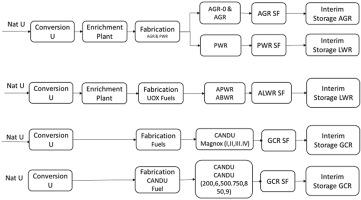Progress in Nuclear Energy ( IF 3.3 ) Pub Date : 2021-04-21 , DOI: 10.1016/j.pnucene.2021.103747 Carlos E. Velasquez , Fidéllis B.G.L. e Estanislau , Antonella L. Costa , Maria Auxiliadora F. Veloso , Claubia Pereira

|
Countries around the world have made an international commitment to decrease the amount of greenhouse gas emissions by 2030 according to the Paris Agreement. Among several power stations options of low carbon emissions, nuclear energy has been proved the most reliable source for electricity production. According to the sustainable development scenario targets, nuclear energy should play an important role in the next years for the decarbonization of the energy system. Countries with consolidated nuclear programmes such as Canada and the UK have similar nuclear fuel technology development, but they have chosen different nuclear fuel cycle options: open fuel cycle and closed fuel cycle, respectively. Both of them have future plans to continue with their nuclear programme. Therefore, this works evaluates the nuclear energy systems for three different scenarios for high, basic and low production of nuclear energy for both countries. The results compare the resources needs, the economy of the nuclear fuel cycle options, the policy of each country and the future of the nuclear power plants to achieve the reduction of the greenhouse gases. The main findings are that reprocessing is a good option for the UK for the whole or partial new nuclear fleet and becomes viable if the price of uranium increases in the market. For Canada, it is worth continuing to increase its nuclear energy up to 1.5 times its current energy capacity. The main difference between the programmes of the two countries is the higher amount of spent fuel generated in the case of Canada due to the choice of reactor technology.
中文翻译:

具有不同核燃料循环选择的国家的核能方案:利用和前景
根据《巴黎协定》,世界各国已作出国际承诺,到2030年减少温室气体排放量。在几个低碳排放的发电站中,核能已被证明是最可靠的电力生产来源。根据可持续发展情景目标,核能应在未来几年中对能源系统的脱碳发挥重要作用。拥有合并核计划的国家(例如加拿大和英国)拥有类似的核燃料技术开发,但它们选择了不同的核燃料循环选择:分别为开放燃料循环和封闭燃料循环。他们俩都有未来计划,以继续其核计划。所以,这项工作针对两国的高,基本和低核能生产三种不同情况评估了核能系统。结果比较了资源需求,核燃料循环方案的经济性,每个国家的政策以及实现减少温室气体的核电厂的未来。主要发现是,对于英国的全部或部分新核舰队来说,后处理是一个不错的选择,并且如果市场上铀的价格上涨,后处理将成为可行的方法。对于加拿大而言,值得继续增加其核能,使其达到其当前能源容量的1.5倍。两国计划之间的主要区别在于,由于选择了反应堆技术,加拿大的乏燃料产生量更高。两国核能的基本和低产量。结果比较了资源需求,核燃料循环方案的经济性,每个国家的政策以及实现减少温室气体的核电厂的未来。主要发现是,对于英国的全部或部分新核舰队来说,后处理是一个不错的选择,并且如果市场上铀的价格上涨,后处理将成为可行的方法。对于加拿大而言,值得继续增加其核能,使其达到其当前能源容量的1.5倍。两国计划之间的主要区别在于,由于选择了反应堆技术,加拿大的乏燃料产生量更高。两国核能的基本和低产量。结果比较了资源需求,核燃料循环方案的经济性,每个国家的政策以及实现减少温室气体的核电厂的未来。主要发现是,对于英国的全部或部分新核舰队来说,后处理是一个不错的选择,并且如果市场上铀的价格上涨,后处理将成为可行的方法。对于加拿大而言,值得继续增加其核能,使其达到其当前能源容量的1.5倍。两国计划之间的主要区别在于,由于选择了反应堆技术,在加拿大,产生的乏燃料量更高。核燃料循环方案的经济性,每个国家的政策以及核电厂的未来,以实现减少温室气体的目的。主要发现是,对于英国的全部或部分新核舰队来说,后处理是一个不错的选择,并且如果市场上铀的价格上涨,后处理将成为可行的方法。对于加拿大而言,值得继续增加其核能,使其达到其当前能源容量的1.5倍。两国计划之间的主要区别在于,由于选择了反应堆技术,加拿大的乏燃料产生量更高。核燃料循环方案的经济性,每个国家的政策以及核电厂的未来,以实现减少温室气体的目的。主要发现是,对于英国的全部或部分新核舰队来说,后处理是一个不错的选择,并且如果市场上铀的价格上涨,后处理将成为可行的方法。对于加拿大而言,值得继续增加其核能,使其达到其当前能源容量的1.5倍。两国计划之间的主要区别在于,由于选择了反应堆技术,加拿大的乏燃料产生量更高。主要发现是,对于英国的全部或部分新核舰队来说,后处理是一个不错的选择,并且如果市场上铀的价格上涨,后处理将成为可行的方法。对于加拿大而言,值得继续增加其核能,使其达到其当前能源容量的1.5倍。两国计划之间的主要区别在于,由于选择了反应堆技术,加拿大的乏燃料产生量更高。主要发现是,对于英国的全部或部分新核舰队来说,后处理是一个不错的选择,并且如果市场上铀的价格上涨,后处理将成为可行的方法。对于加拿大而言,值得继续增加其核能,使其达到其当前能源容量的1.5倍。两国计划之间的主要区别在于,由于选择了反应堆技术,加拿大的乏燃料产生量更高。











































 京公网安备 11010802027423号
京公网安备 11010802027423号